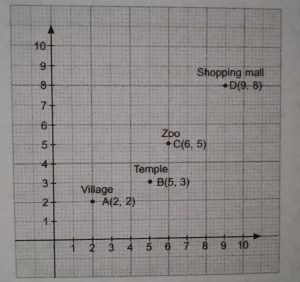Case study Chapter 10( Vector )
Case study 1: A man is watching an aeroplane which is at the co-ordinate point A(4, -1, 3) assuming that the man is at O(0, 0, 0). At the same time he saw a bird at the coordinate point B(2, 0, 4).(Case study problem vector 2)
Based on the above information answer the following:
(a) Find the position vector ![]()
(b) Find the distance between aeroplane and bird
(c) Find the unit vector along ![]() .
.
(d) Find the direction cosine of ![]() .
.
(e) Find the angles which ![]() makes with x, y and z axes.
makes with x, y and z axes.
Solution: (a) A(4, -1, 3) and B(2, 0, 4)
Then, ![]()
![]()
(b) Distance between A and B
![]()
![]() units
units
(c) Unit vector along AB ![]()
![]()
![]()
(d) Direction cosine of ![]() are
are
![]()
(e) Since,
![]()
![]()
Again, ![]()
![]()
Again, ![]()
![]()
Case study 2: Ishan left from his village on weekend. First, he travelled up to temple. After this , he left for shoping

in a mall. The position of Ishan at different places is given in the following graph.
Based on the above information, answer the following question
(a) Find the position vector of B.
(b) Find the position vector of D.
(c) Represent the vector ![]() in the form of i,j.
in the form of i,j.
(d) Determine the length of vector ![]() .
.
(e) If ![]() , then find its unit vector.
, then find its unit vector.
Solution: Here (5, 3) are coordinate of B
(a) Since,position vector of B is ![]()
![]()
(b) Here (9, 8) are co-ordinates of D
Then position vector of D ![]()
![]()
(c) ![]()
and ![]()
![]()
![]()
![]()
(d) ![]()
![]()
![]()
![]()
![]()
![]()
![]() units
units
(e) We have ![]()
![]()
![]()
![]()
![]()
![]()
![]()
Case study 3: Employee in a office are following social distance and during lunch they are sitting at places marked by
points A, B and C. Each one is reoresenting position as ![]() and
and
![]() .
.
Based on the above information answer the following:
(a) Find the distance between A and B.
(b) Find the distance between B and C.
(c) Find the position vector ![]() .
.
(d) Find the unit vector along ![]() .
.
(e) Find the area enclosed by A, B and C.
Solution: (a) Since, ![]()
![]()
![]()
![]()
![]()
![]()
![]()
(b) ![]() .
.
![]()
![]()
![]()
![]()
![]()
![]()
(c) ![]()
(d) ![]()
![]()
![]()
![]()
![]()
(e) Since,
![]()
Area of triangle ABC ![]()

![]()
![]()
![]()
![]()
![]()
Area ![]()
![]() sq.units
sq.units
Some other Case study question:
Solar panels have to be installed carefully so that the tilt of the roof, and the direction to the sun , produce the largest possible electrical power in the solar panals.(Case study problem vector 1)
A surveyor uses his instrument to determine the co-ordinates of the four corners of a roof where solar panels are to
be mounted. In the picture, suppose the points are labelled counter clockwise from the roof corner nearest to the
camera in units of meters ![]() and
and ![]() .
.
Based on the above information answer the following question.
Solution: for solution click here

